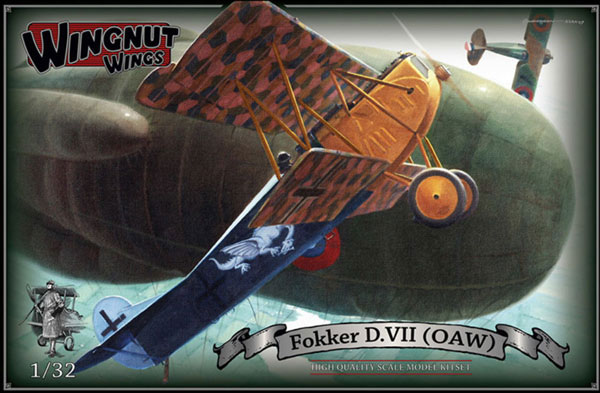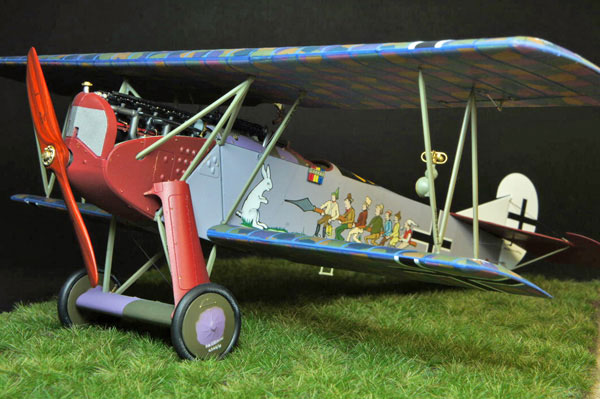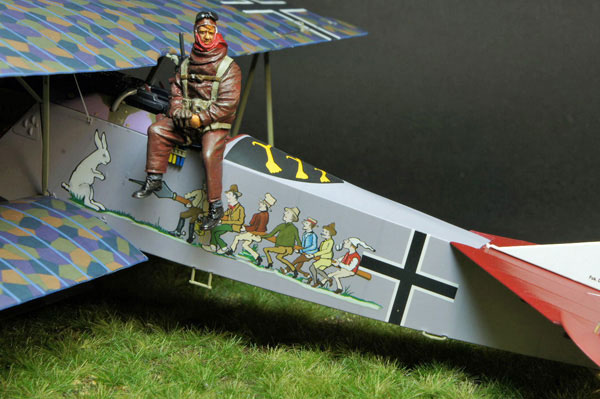
Feature article by Dave Coward
Our thanks to Wingnut Wings for supplying our review sample. Get this kit and all the other superb kits in the WW range here now at: www.wingnutwings.com
Check out your Finished Now area in SMN via this link to see the multiple builds of Wingnut Wings kits that have been completed so far
Intro from Geoff
Once again it’s great to be able to bring you a couple of photos of Dave’s completed Fokker D.VII (OAW) right at the start of his build. Looks impressive, doesn’t it? Dave has some excellent advice that will help you greatly in your build with this one, especially in relation to fit and the engine so worth a good look at this if you have this kit to build.
One of the things that I love about this build is the incredible fuselage artwork – Dave explains all about that too – hope you enjoy this feature article as much as I did!


Background
The legendary Fokker D.VII is widely considered the best German fighter aircraft to emerge from the Great War, it was certainly the most numerous and as such was the only aircraft specifically requested to be surrendered in the Allies armistice terms. In early 1918 the young Jasta pilots were mainly equipped with Albatros D.Va, Pfalz D.IIIa and the Fokker Dr.1 Triplane which were no match for the SE.5a, SPAD 13 and Sopwith Camels that they faced each day. Fokker’s prototype D.VII (the V.11) impressed the front line pilots present at the First Fighter Trials in January-February 1918 so much that word soon started to leak out about a new Fokker that would once again return air superiority to the Germans. So great was the need for this promising new fighter that, in addition to production at Fokker, Albatros were ordered to manufacture it under license at their Johannisthal (Alb) and Schneidemühl (OAW – Ostdeutsche Albatros Werke) factories, incidentally building nearly twice the number of D.VII as Fokker!
In keeping with previous Fokker design practices the D.VII featured a welded steel tube fuselage and tailplane along with thick ‘high lift’ wings of conventional wood and wire construction. A few early production machines were powered by the 180hp Daimler-Mercedes D.IIIa but most production aircraft were fitted with the 200hp D.IIIaü, although a small number received the new BMW IIIa 185ps (rated at 230hp by the British) ‘altitude’ engine. Interestingly, although only shown in a handful of known photos, some late production Fokker D.VII were powered by the long outclassed 160hp Daimler-Mercedes D.III engine. Initially supplied in small number to the most experienced pilots of the elite Jagdgeschwader 1 from late April 1918 the Fokker D.VII quickly started to make a name for itself and allied pilots suddenly found that they could no longer count on their superior performance at higher altitudes. In the middle of 1918 the Fokker D.VII was plagued with a series of often fatal mid-air fires variously attributed to overheating, fuel tank stress damage and the volatile incendiary ammunition used for ‘balloon busting’. An immediate response to this was removing the top cowlings for improved cooling followed by modified side cowlings with louvers to ventilate the engine bay more efficiently.
By the end of the Great War the Fokker D.VII was the main aircraft type equipping the German Jastas and despite the Daimler-Mercedes powered D.VII being very well received, it was the Fokker D.VII fitted with the coveted BMW IIIa ‘altitude’ engine that all Jasta pilots longed to fly. Towards the end of the war a number of D.VII were ordered for the Austro-Hungarian Luftfahrtruppe to be built by Fokker (225), Aviatik (255) and MAG (150). Following the Armistice the Fokker D.VII found its way into numerous countries air forces including Argentina, Belgium, Bulgaria, Czechoslovakia, Denmark, Finland, Hungary, Netherlands, Lithuania, Poland, Romania, Soviet Union, Sweden, Switzerland and the American USAS and USMC.
Aftermarket Extras:
- Wingnut Wings `Fighting Fokkers` Part 4
- EZ Line
- HGW Seat Belts
- Gaspatch Models Turnbuckles
- Gaspatch Models Anometer